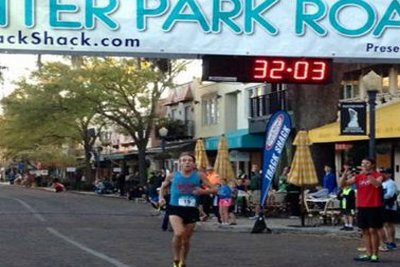Dealing with Race Anxiety
Susan S. Paul, MSTrack Shack Training Program Director
We all experience some level of race anxiety before a race no matter how long we have been racing. The first step to dealing with race anxiety is acknowledging it. Simply recognizing that it is a perfectly normal part of racing is reassuring. To some degree, race anxiety is a good thing because it helps prepare us for peak performance but, it can also lead us to doubt our training and ourselves, so learning how to manage it is the key.
Here are some pre-race tips to help keep you calm, centered, focused, and prepared for a great experience!
1) Trust your Training- When you feel race anxiety kicking in, acknowledge it for what it is, normal pre-race jitters. Take a deep breath, exhale forcefully and relax. You did the training and now you are ready for the race. Don't second-guess yourself and start changing things up now. Stick to how you trained for the race because this is what your body knows. You can always make training adjustments AFTER the race, if warranted. Analyzing your race performance can help you decide if there are things you want to do differently next time around.
2) Stay the Course- Keep your entire daily routine as close to your normal routine as possible up to race day. This means eat the same foods, wear the same clothing, wear the same shoes, use the same run nutrition, run the same pace, use your run nutrition at the same times, follow the same hydration plan, sleep the same hours, and wake up at the same time. Changing things up now can really throw your body (and your mind) off. If you shop the race expo, save any new purchases for after the race!
3) Visualization- Think ahead and re-create race day in your mind. Visualize getting up, getting dressed, eating breakfast, going to the race, running, taking run nutrition/hydration, crossing finish line, and receiving your medal. Next, visualize post-race, collecting your gear bag, changing clothes, and meeting up with family and friends. Imagine all your needs for the entire day as you go through the visualization process. Visualization accomplishes many things but, of special importance, it helps calm and prepare you for race day. Also, picturing the day helps you think through everything you might need for the day, pre-race, race, and post-race.
4) Be Prepared- The day before the race, lay out your race day clothing, pin on your bib number, and set out shoes and socks. Plan on layering clothing so you can stay warm before the race and then easily shed them as you go. Pack your gear bag for post-race needs too. It's important to get out of wet clothing quickly so bring a towel and a warm change of clothes. Pack anything you might need like special snacks or medication too. It's also a good idea to bring a big lawn bag. Make a small slit in the bottom of the bag so you can slip it over your head and wear it for added warmth and protection from wind and rain. It's easy to toss aside once the race starts. And, if you are going to be sitting in a corral for a while, garbage bags can be nice to sit on too! Take the time to READ your pre-race instructions so you know where to park, what time to arrive, where to check your gear bag, and where to find the family/friends reunion area.
5) Bathroom Issues- One concern many runners have is dealing with bathroom issues/GI distress on race day. If this is a concern, reduce the amount of fiber you eat for two days leading up to the race by eliminating whole grain or high fiber products. It sounds counter-intuitive, but remember, we are talking about only a couple of days. Also, eliminate any foods known to irritate the GI tract like caffeine, sugar, dairy products, wheat or gluten, fats, fried foods, and artificial sweeteners for several days prior to the race. Pack a few wet wipes in a small plastic bag and carry them with you for emergencies.
Eat your pre-race dinner earlier rather than later to give you plenty of digestion time. If you like to "carbo load" do so two nights before the race, rather than the night before. Eating a large dinner the night before the race can leave you feeling bloated and full on race morning. Race anxiety can impact our digestion process, making it less efficient, so a large pre-race dinner might not sit well.
5) Lubricate Everything- Even if you never experienced chafing while training, racing can bring on chafing. Perhaps the added intensity of racing changes up our stride just enough to create rubbing where there was no rubbing before, or perhaps race anxiety increases sweat production that leads to chafing. Whatever the reason, it seems chafing is much more common on race day. Purchase some type of anti-chafing product and coat everything, including thighs, underarms, jog bra area, and feet. Coat your feet, then turn your sock inside out and apply lubricant directly to the fabric, then turn the sock right side out and slide it on.
6) Negative Splits- Running negative splits means starting out slow and gradually dropping the pace so each mile becomes faster and faster. Ideally, the second half of your race is faster than the first half. Don't waste energy weaving in and out of the crowds when the race starts. Place yourself appropriately at the start, whether by pace per mile if designated, or report to your assigned corral. Starting "slow" means a pace that is slightly slower than your goal race pace by approximately 30 to 45 seconds per mile. This allows your body time to relax and warm up. Focus on how you feel and your breathing. Let the race come to you; don't force the pace. Once you find your running rhythm, gradually begin picking up the pace.
7) Lack of Sleep- Don't worry about not sleeping well the night before the race. Fortunately, research has shown that this lack of sleep before a race does not impact performance. Try to get adequate sleep during the week leading up to the race and then you can catch up on any lost sleep after the race! Set your alarm clock, allow plenty of time to get up, eat, and get to the race early. You might even want to have a back up alarm set, just in case!
8) Make a Recovery Plan- You had a training plan for your race and now you need a recovery plan. A recovery plan can help you return to running safely after a race. Give yourself 1 to 3 days completely off from running after the race; sleep in, relax, and enjoy your accomplishment. Then, start your return to running with some short easy runs and gradually build your mileage back up. Note any aches or pains, notice your breathing rate and heart rate, and any fatigue. If your legs feel heavy or sore, or your heart rate spikes, or your breathing is heavy, it's a sign of fatigue. Your body is letting you know it's not yet recovered from the race, so take it easy! Part of your recovery plan can include choosing your next race too! What are your goals after this race? There are so many choices! A Half-marathon? A marathon? Or, do you want to work on speed? Recovery is a great time to make some new goals and decide what you want to do next! Remember, anything is possible!







